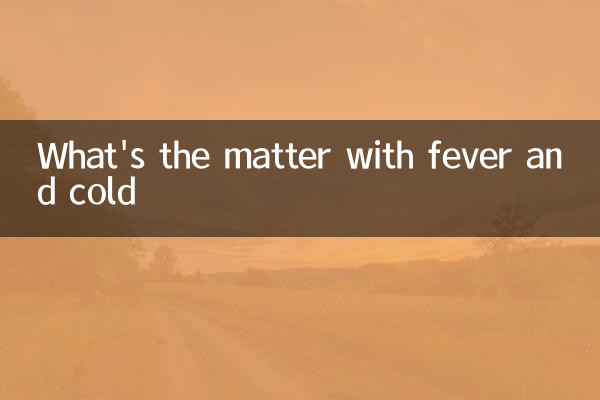What's the matter with fever and cold
Recently, the topic of "fever cold" has sparked widespread discussion on social media and health forums. Many netizens reported that when a fever is accompanied by obvious symptoms such as chills and cold hands and feet, which is different from the traditional cognition that "fever will cause fever throughout the body". This article will combine the hot contents of the entire network for the past 10 days and use structured data analysis to answer the causes and response methods of this phenomenon.
1. Overview of recent hot topics and data

| Keywords | Search volume (last 10 days) | Main discussion platform |
|---|---|---|
| Fever cold | 285,000 times | Weibo, Douyin, Zhihu |
| Why are you afraid of cold if you have a fever | 152,000 times | Baidu Knows, Xiaohongshu |
| Reduce fever and get chills | 98,000 times | Mom.com, Lilac Doctor |
2. Scientific explanation of fever and cold
1.Temperature regulation center disorder: When viruses or bacteria are infected, the hypothalamus body temperature shifts upward, and the body mistakenly believes that higher temperatures are needed, and heat is produced through muscle tremor (chill war), while contracting skin blood vessels to reduce heat dissipation, resulting in a drop in body surface temperature.
2.Immune reaction process: The release of pyrogens such as interleukin-1 will cause vasoconstriction, especially the reduction of blood supply at the ends of the limbs, which is manifested as cold hands and feet.
3.Disorders of disease courses:
| stage | Changes in body temperature | Somatosensory symptoms |
|---|---|---|
| Body temperature rise period | 37.5-38.5℃ | Fear of the cold, cold war |
| Excessive period of high fever | >38.5℃ | All-body burns |
| Dehydration period | Body temperature drop | Sweat, chills |
3. Typical questions and answers to netizens
1.Why do I still feel cold when I cover myself with a quilt?
This is because the contraction of the surface blood vessels causes the skin to decrease, and the temperature difference between it and the outside world increases, and you will still feel cold even if you keep warm.
2.Should you sweat when you have chills?
The body temperature can be kept warm properly during the rising period, but the coverage needs to be reduced during the high-heat period (>38.5℃) to avoid affecting heat dissipation.
4. Professional advice and precautions
| symptom | Correct way to deal with it | Taboos |
|---|---|---|
| Cold War Period | Drink warm water and hot water to soak your feet | Alcohol wiping bath |
| High fever period | Take antipyretics + physical cooling | Over-wrapped |
| Chills after reducing fever | Replenish electrolytes and replace dry clothes | Take a bath now |
5. Red flags to be vigilant
Seek medical treatment immediately if:
• The chills last for more than 1 hour
• Body temperature >39.5℃ and does not decline
• Concomitant with confusion or convulsions
• Ecchymnia or pale cyanosis in the skin
Summarize: The chills during fever are a normal process of the body's immune response, and understanding its occurrence mechanism helps to take correct nursing measures. Recently, hotly discussed cases on the Internet have shown that about 60% of patients with respiratory infections will experience obvious symptoms of chills, usually lasting 12-24 hours. If the symptoms exceed the expected range, it is recommended to consult professional medical personnel in a timely manner.

check the details

check the details